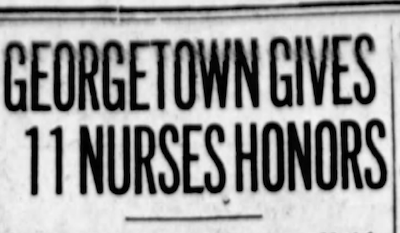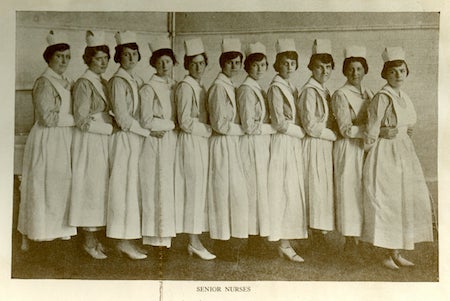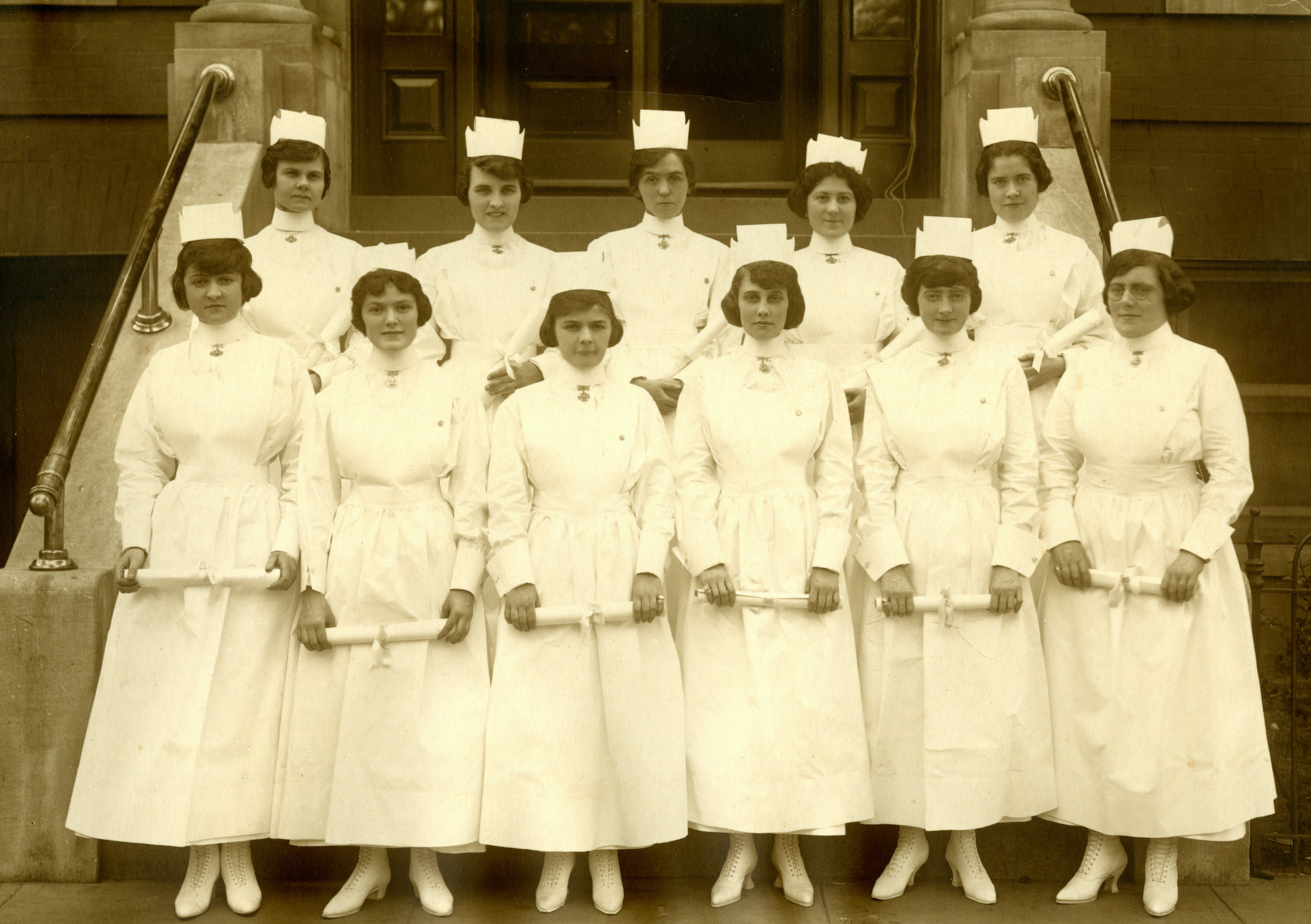One Hundred Years Ago, GU Nursing Graduates Praised for Work During Flu Pandemic
December 11, 2020 – As alumni of the School of Nursing & Health Studies have been working hard on the front lines of the COVID-19 response for months, a look back 100 years reveals nursing graduates being praised for their work during the 1918 influenza. (Read COVID-19-related stories from NHS.)
A news article from June 2, 1920, “Georgetown Gives 11 Nurses Honors,” noted that during the preceding day’s graduation in Gaston Hall, the university president celebrated the students’ commitment.

The headline in the June 2, 1920 issue of the Washington Times. (Image Newspapers.com)
“Rev. John B. Creeden, S. J., president of Georgetown University, and Rev. Aloysius P. Brosnan, S. J., who made the address to the graduates, paid tributes to the Sisters of St. Francis who conduct the hospital and to the graduates for their faithful duties performed during the influenza epidemic when not one of the nurses failed to respond to the call for charity,” the Washington Times reported.
The nursing Class of 1920 received diplomas and some a special medal from Dr. George Tully Vaughn, a medical school faculty member.
In the first decades of the 20th century, education in nursing was different than it is today, according to Dr. Alma Woolley. In her Learning, Faith, and Caring: History of the Georgetown University School of Nursing, 1903-2000 (2001), the former Georgetown dean wrote that “pupil nurses” offered every aspect of care in the hospital, and “long hours, hard labor, and strict discipline were the rule in all schools.”
The Flu at Georgetown
The 1919 and 1920 editions of Ye Domesday Booke, a Georgetown yearbook, described the impact of the influenza on campus. The publications reported two student deaths, one of whom, a law student, had died at Georgetown University Hospital in October 1918.
Authors of the text in the 1919 yearbook – which, in that particular year, was produced by the seniors at the law school – explained, “. . . many of our class were in the service, while the influenza epidemic spread its deadly influence on all sides. For a time lectures were continued, but later the school was ordered to be closed by the Commissioners of the District as a preventive against its spreading. But November 4th brought us together again, and our numbers began to increase by leaps and bounds, due to the armistice and rapid demobilization of the troops.”
The November 1918 issue of the Georgetown College Journal noted how the Law and Medical Schools closed for a period of time, while the January 1919 issue indicated the College did not.
The journal read, “While the influenza was epidemic, we were fortunate in being comparatively free from the plague—all suspected cases being relegated to a place of quarantine. A barrier was put against the entrance of externs unaccompanied by a health certificate. Special permission was obtained lo allow the academic classes lo proceed without interruption. Our student body can boast of three months of consecutive academic work though modified in character and time.”
Dr. Robert Emmett Curran – in his second volume of A History of Georgetown University (2010) – wrote about the 1918 pandemic as well.
“The first cases showed up at the college in late September . . . ,” he recounted. “By October 2, seventeen students were afflicted. The stricken were quarantined in the infirmary. As their numbers grew, they quickly filled all the beds and were on mattresses borrowed from the hospital. Five nurses attended the sick.”

An image of the senior nursing class from the 1920 Ye Domesday Booke yearbook. (Image courtesy Georgetown University Archives)
‘Strong in Quality’
In the 1920 yearbook, a reflection, presumably written by the graduating student nurses, highlighted the strenuous demands of hospital life. They described how the class lost 12 students during the course of study – dropping from 23 to 11.
“But it is only to be expected that years of hard training and serious study would tax the strength of many,” the authors wrote. “. . . Some of those who started out with us as Juniors left us because of health, others needed a stronger will to brave the storms of a pupil nurse’s life, but we who have overcome the difficulties, though not strong in number are strong in quality—even though we do say it ourselves.”
The students did not specifically mention the influenza, and the writers seemed to take all the challenges they had faced in stride as part of their education.
“Nothing we might call eventful happened during our three years within the walls of Georgetown Hospital, but to all of us they have been most pleasant and each day has brought us nearer to one another and to our Alma Mater,” the authors wrote.
Looking to the future and their responsibilities, they offered, “. . . we trust that [classmates’] lives will be ever so devoted to duty that each and every one of us will be a credit to the institution from which we graduated.”
By Bill Cessato
A special thanks to Lynn Conway, the archivist of Georgetown University, for her time reviewing a draft of this story and offering suggestions, as well as sharing her expertise about Georgetown history and very helpful resources to review.
- Tagged
- COVID-19
- Nursing History

